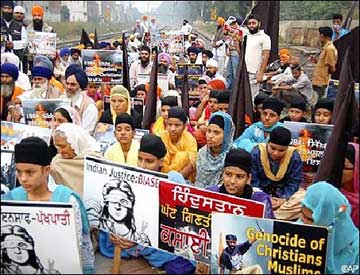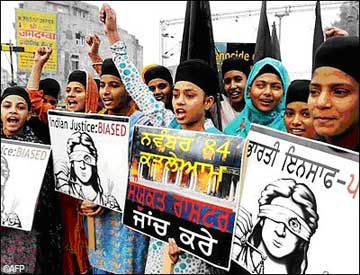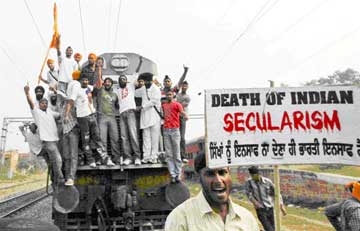
Archive 2009
|
Novermber 16-30, 2009
Widespread protests on the anniversary of the 1984 massacres Punish the guilty!
Twenty-five years ago, a mass murder of people belonging to the Sikh community was organised with the full backing of the Indian state, in the aftermath of the assassination of the then Prime Minister, Indira Gandhi on 31st October 1984. Leading functionaries of the Congress Party led marauding mobs in singling out people belonging to the Sikh faith. Men were murdered and burnt alive in front of their families, women were raped in the presence of their children, and property was wantonly destroyed. The prowling mobs had come armed with lists of houses in which Sikh families lived, provided by the state authorities. Passengers were pulled out of trains and killed. The carnage continued for days on end, in the capital of the country, Delhi, as well as in many other towns and cities across India. Police in Delhi and other places looked the other way and refused to help those who asked for protection against the rampages. On the other hand, ordinary people of other communities showed great courage and humanity in sheltering Sikh families from the state – organised genocide.
Throughout the twenty five years which have since elapsed, our rulers have ensured that the guilty are not punished, and moreover, that people resign themselves to the situation. Moreover, several other crimes against the people, targeting people of different communities, have been organised, such as the state-organised communal violence in Mumbai in 1993, the Gujarat massacres of 2002, the pogroms against Christians in Orissa and other regions in 2007 – 08 and so on. After every such crime, events follow a familiar pattern – commissions of enquiry are set up whose proceedings carry on for years on end, a few lower level goons prosecuted perhaps, while the political bigwigs who organise these crimes against humanity escape scot free. It is clear that state organised communal violence is a preferred method of the ruling class in India to keep the people divided and rule over them. However the massive protests in Delhi and across many towns of Punjab as well as in other cities of India show that people will not easily accept this design of the ruling class. In New Delhi, a militant protest was held on Saturday, 31st October 2009 outside the Kakardooma court, where a case against one of the senior Congress Party functionaries was in progress. On 1st November 2009, a massive “march for justice” proceeded from the historic Bangla Sahib Gurudwara, in which people from all faiths participated. The protestors demanded that all those guilty should be speedily punished, no matter how highly placed they may be. They also demanded that a detailed census be carried out of the number of people killed in the violence. The protests in Punjab were organised over several days. The whole of Punjab was shut down in the wake of a call given to protest against lack of justice in punishing the guilty. Trains were stopped in many towns, including Jallandhar, Ludhiana, Amritsar etc on Tuesday, 3rd November 2009. Blockades were set up by protestors between Rajpura and Shambu on the mainline Ambala Ludhiana section which provides a link to the national capital and Jammu and Kashmir. Protests have also been reported from many other cities of India including Mumbai, Hyderabad and Kolkata. |



